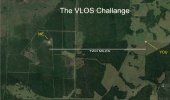There have been numerous drone pilots fined by the FAA over the years. Keep in mind though, it is rare that anyone fined by the FAA has only broken a single regulation. Most times there are multiple infractions and breaking VLOS is but one of them. This is because people who break one rule tend to break many others - of course in their minds - its more like they're "bending" the rule - only to find out the FAA doesn't see it that way.

Indeed, most of the cases I've seen or heard of; the ones being fined are chronically ignorant or suffer from a very serious case of Anti-Authority - or perhaps both?

One case more recently was "The Philly Drone Guy" - he was fined 182,000.00 (Yes, one hundred and eighty-two thousand dollars) for 123 separate infractions - flying BVLOS on multiple occasions accounted for a number of those infractions. Remember, each time he did it was another infraction and another fine that all tallied up to the total.
Sometimes those investigations can take months or years by which time most folks (especially some drone pilots)

have long forgotten the story ever existed. Perhaps
@BigAl07 has more information on this?










